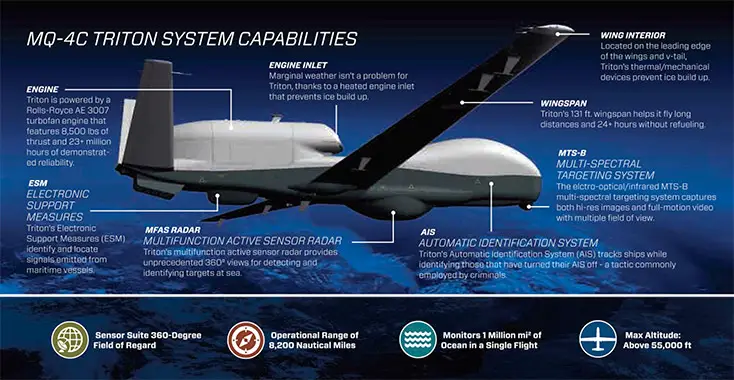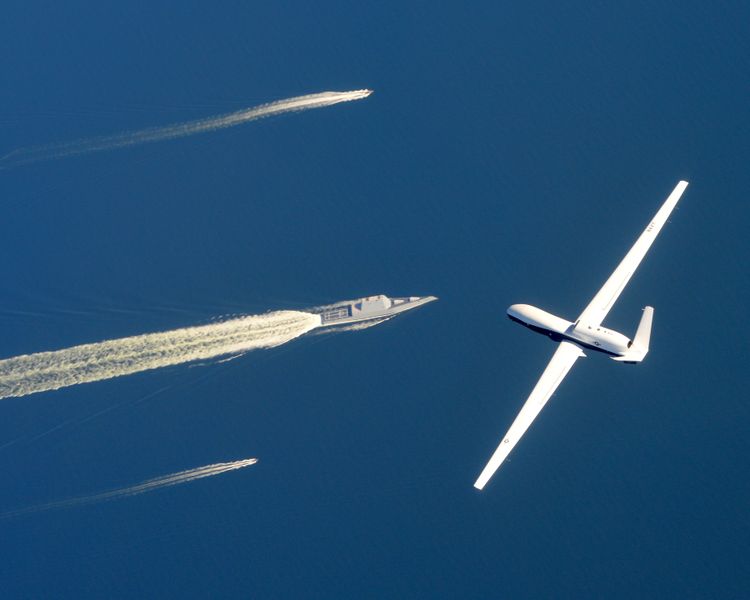Northrop Grumman Systems Corp., San Diego, California, is awarded a $333,401,760 modification to previously-awarded fixed-price-incentive-firm-target contract N00019-19-C-0008. This modification exercises options for the production and delivery of three low-rate initial production MQ-4C Triton unmanned aircraft, two main operating bases and one forward operating base in an integrated functional capability-four and multiple-intelligence configuration, with associated export compliance support for the government of Australia. Work is expected to be completed by April 2025. Foreign cooperative project funds for $27,601,190 will be obligated at time of award, none of which will expire at the end of the current fiscal year. The U.S. Naval Air Systems Command, Patuxent River, Maryland, is the contracting activity.
The MQ-4C can remain aloft more than 30 hours at 55,000 ft (17,000 m) at speeds of up to 330 knots (380 mph; 610 km/h). Its surveillance sensor is the AN/ZPY-3 Multi-Function Active Sensor (MFAS) X-band AESA radar with a 360-degree field-of-regard, capable of surveying 2,700,000 sq mi (7,000,000 km2) of sea (as well as shoreline or land) in a 24-hour period, or 2,000 sq mi (5,200 km2) in a single sweep. Using the radar in inverse synthetic aperture mode, the MFAS can identify a target in all weather conditions. It can take high definition radar pictures, then use the advanced image and radar return recognition software of the onboard Automatic Identification System (AIS) to classify it without the intervention of aircraft operators. The Triton is semi-autonomous to conserve manpower, so operators only need to choose an operating area for the aircraft.

The Northrop Grumman MQ-4C Triton is an American high-altitude long endurance unmanned aerial vehicle (UAV) under development for the United States Navy as a surveillance aircraft. Together with its associated ground control station, it is an unmanned aircraft system (UAS). The system is intended to provide real-time intelligence, surveillance and reconnaissance missions (ISR) over vast ocean and coastal regions and to complement the Boeing P-8 Poseidon maritime patrol aircraft. Triton builds on elements of the RQ-4 Global Hawk; changes include reinforcements to the air frame and wing, de-icing systems, and lightning protection systems. These capabilities allow the aircraft to descend through cloud layers to gain a closer view of ships and other targets at sea when needed.
On 13 March 2014, Prime Minister Tony Abbott announced Australia’s intention to buy the MQ-4C Triton and become its first foreign customer. The Triton buy is part of the Australian Defence Force’s Project Air 7000 two-phase Orion replacement program; Phase 1B entails procuring the Triton, and Phase 2B is the acquisition of eight-to-twelve manned P-8A Poseidons in 2017. RAAF Tritons and Poseidons will be used in a similar complementary fashion as with U.S. Navy operation, where the MQ-4C performs high-altitude broad area surveillance missions, allowing the P-8A to be more dedicated to anti-submarine and anti-surface warfare, search and rescue response, and electronic intelligence missions. On 26 June 2018, Australian Prime Minister Malcolm Turnbull announced the purchase of the first of six MQ-4C Tritons with consideration being given to purchase a seventh.[32]
